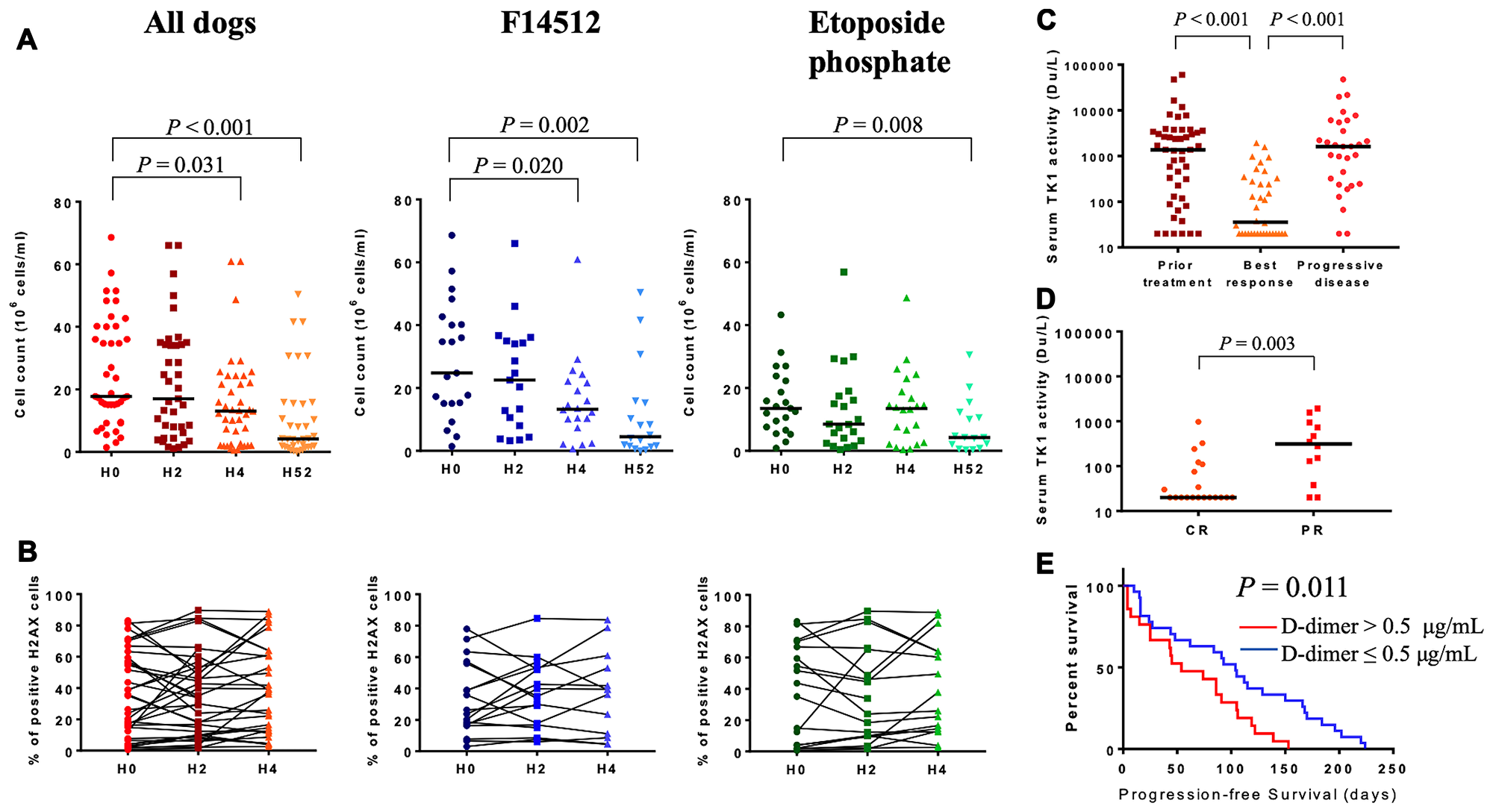Oncotarget Volume 11, Issue 7 features Figure 4, "Exploratory biomarkers," by Boyé, et al.
The objective of this study was to compare the safety and antitumor activity of F14512 and etoposide phosphate in dogs with spontaneous non-Hodgkin lymphoma and to investigate the potential benefit of F14512 in P-glycoprotein overexpressing lymphomas.
Subgroup analysis of dogs with Pgp-overexpressing NHL showed a significant improvement in PFS in dogs treated with F14512 compared with etoposide phosphate.
F14512 showed strong therapeutic efficacy against spontaneous NHL and exhibited a clinical benefice in Pgp-overexpressing lymphoma superior to etoposide phosphate.
Dr. Pierre Boyé from OCR (Oncovet-Clinical-Research), in Loos France as well as Oncovet, in Villeneuve d'Ascq France and the Department of Small Animal Teaching Hospital at The Royal (Dick) School of Veterinary Studies and The Roslin Institute, University of Edinburgh, UK said in their Oncotarget article, "Comparative oncology has shown that naturally occurring canine cancers are of valuable and translatable interest for the understanding of human cancer biology and the characterization of new therapies."

Figure 4: Exploratory biomarkers. (A) Total surviving cells count measured by flow cytometric analysis at H0, H2, H4 and H52 following treatment initiation. Drug infusion was started at H0. The horizontal bars represent median. (B) Percentage of γ-H2AX expression in surviving cells at H0, H2, H4 following treatment initiation. Groups were compared using Wilcoxon rank test. (C) Serum thymidine kinase 1 activity (Du/L) in dogs prior to treatment initiation (n = 48), at the time of the best clinical response (n = 36) and at the time of progressive disease (n = 30). Minimum detectable activity for this assay: 20 Du/L. The horizontal bars represent median. (D) Serum thymidine kinase 1 activity in dogs with complete (CR, n = 20) and partial (PR, n = 12) response. Minimum detectable activity for this assay: 20 Du/L. The horizontal bars represent median. Levels of sTK1 activity between groups were compared using Wilcoxon rank test. (E) Kaplan-Meier curve in dogs with high (> 0.5 mg/mL, n = 21) or low (≤ 0.5 mg/mL, n = 27) pretreatment D-dimer levels. Log-rank P value is shown.
Comparative oncology has shown that naturally occurring canine cancers are of valuable and translatable interest for the understanding of human cancer biology and the characterization of new therapies.
Dogs develop a broad spectrum of spontaneously occurring cancers that share strong similarities with human cancers, offering a singular opportunity to answer key questions and guiding the cancer drug development path in a manner not possible using more conventional models.
The antiproliferative activity of F14512 has been demonstrated to be superior to etoposide in numerous human cancer cell lines such as breast cancer, non-small cell lung cancer, leukemia, melanoma, ovarian cancer, and carcinomas.
In a vinorelbine-resistant P388 mouse leukemia cell line model overexpressing a high level of functional P-glycoproteins, F14512 displayed a strong antileukemic activity and the antitumor activity of F14512 was not impacted by the MDR status of cancer cells.
"The objective of this study was to compare the safety and antitumor activity of F14512 and etoposide phosphate in dogs with spontaneous NHL and to investigate the potential benefit of F14512 in P-glycoprotein overexpressing lymphomas, with the primary aim of showing that effectively designed comparative oncology studies would offer bidirectional benefit to both pet animals and humans with cancer."
- Dr. Pierre é, OCR (Oncovet-Clinical-Research), Oncovet, the Department of Small Animal Teaching Hospital at The Royal (Dick) School of Veterinary Studies, and The Roslin Institute, University of Edinburgh
The Boyé Research Team concluded in their Oncotarget paper that the data reported here illustrate that spontaneous cancers in dogs offer a unique opportunity to integrate pet dog studies into the development paths of new cancer drugs.
Sign up for free Altmetric alerts about this article
Full text - https://doi.org/10.18632/oncotarget.27461
Correspondence to - Pierre Boyé, [email protected]
Keywords - etoposide phosphate, F14512, non-Hodgkin lymphoma, pet dog model, P-glycoprotein
About Oncotarget
Oncotarget is a biweekly, peer-reviewed, open access biomedical journal covering research on all aspects of oncology.
To learn more about Oncotarget, please visit https://www.oncotarget.com or connect with:
SoundCloud - https://soundcloud.com/oncotarget
Facebook - https://www.facebook.com/Oncotarget/
Twitter - https://twitter.com/oncotarget
LinkedIn - https://www.linkedin.com/company/oncotarget
Pinterest - https://www.pinterest.com/oncotarget/
Reddit - https://www.reddit.com/user/Oncotarget/
Oncotarget is published by Impact Journals, LLC please visit https://www.impactjournals.com/ or connect with @ImpactJrnls
Media Contact
[email protected]
18009220957x105


